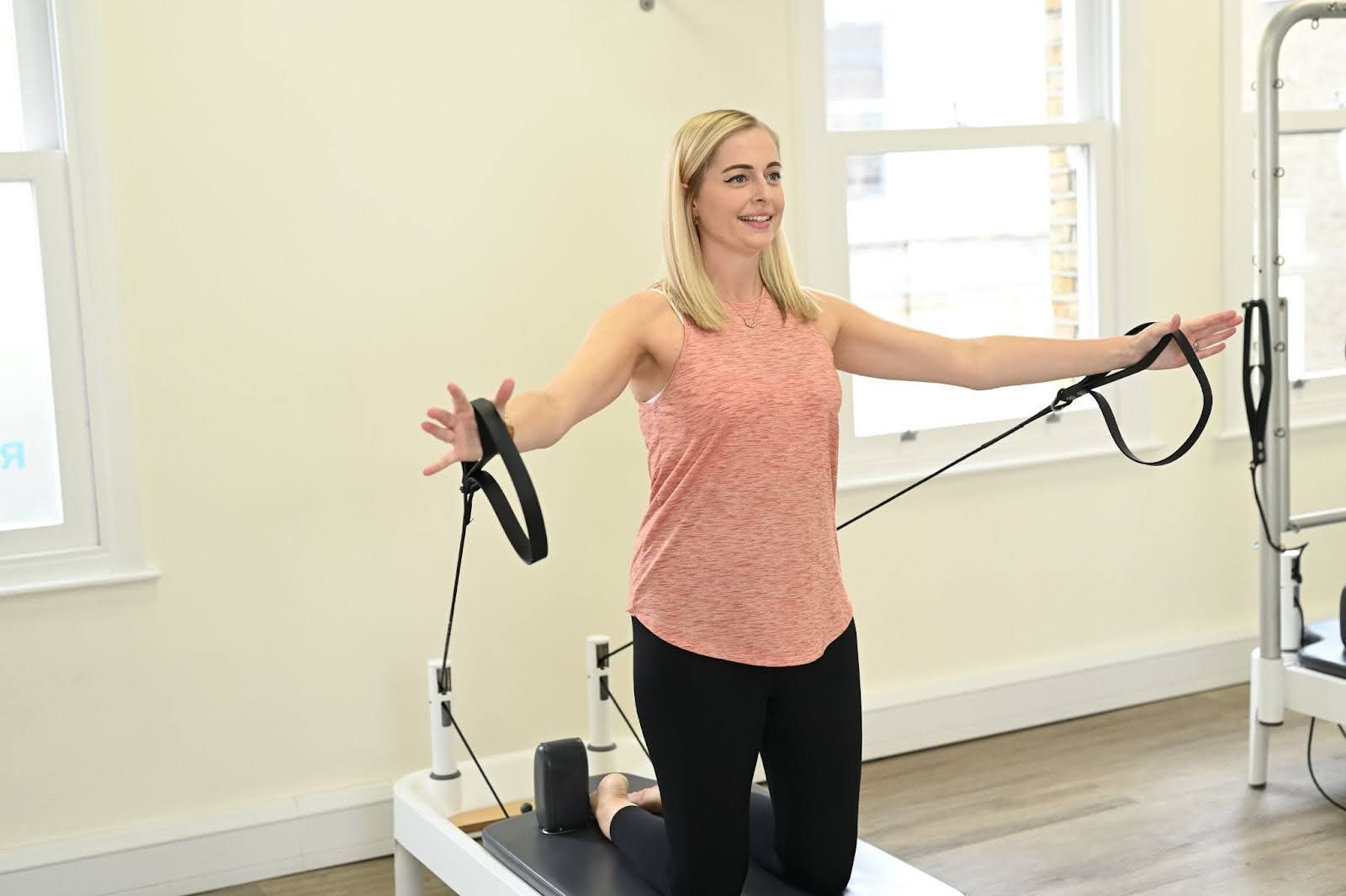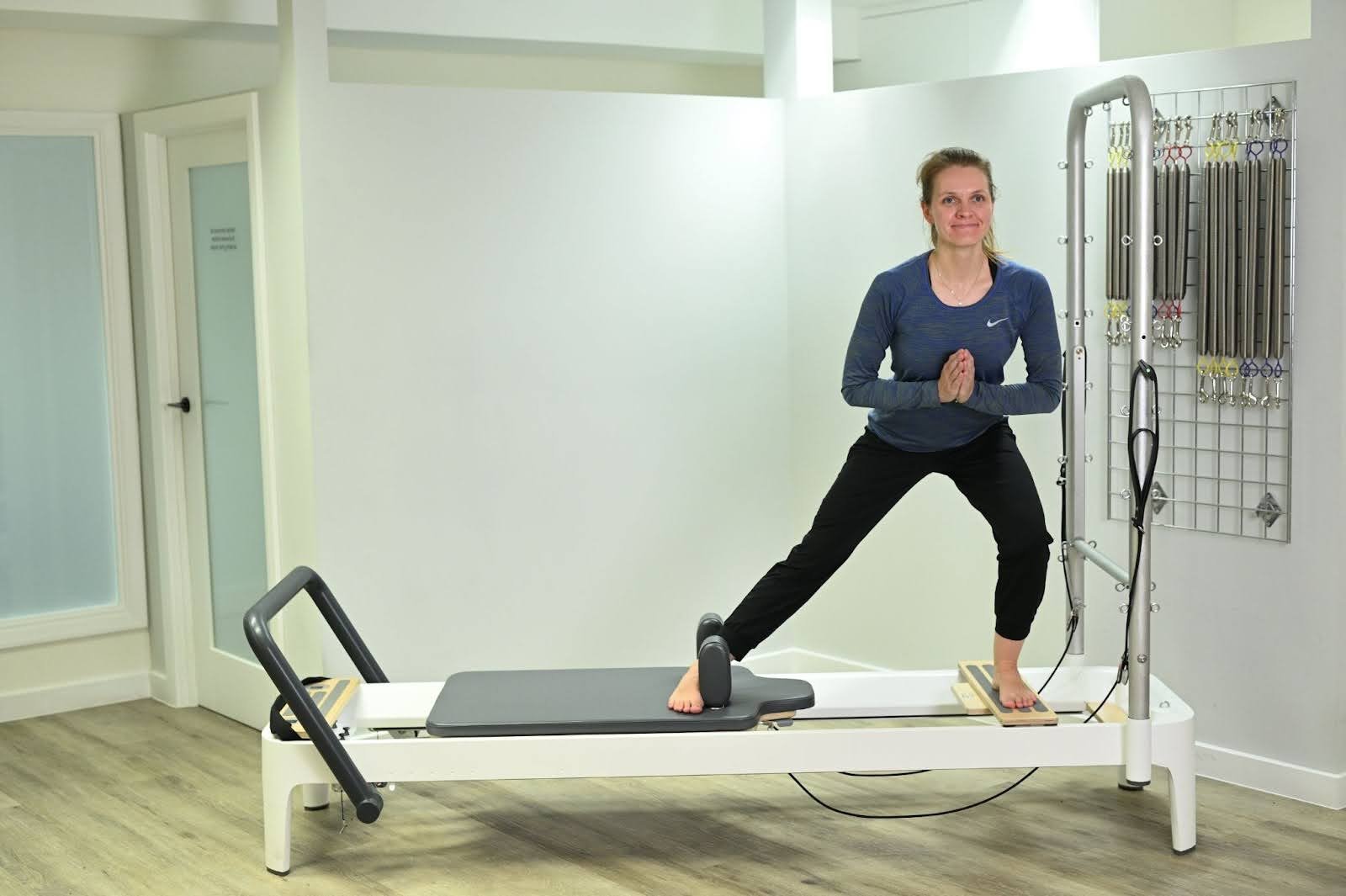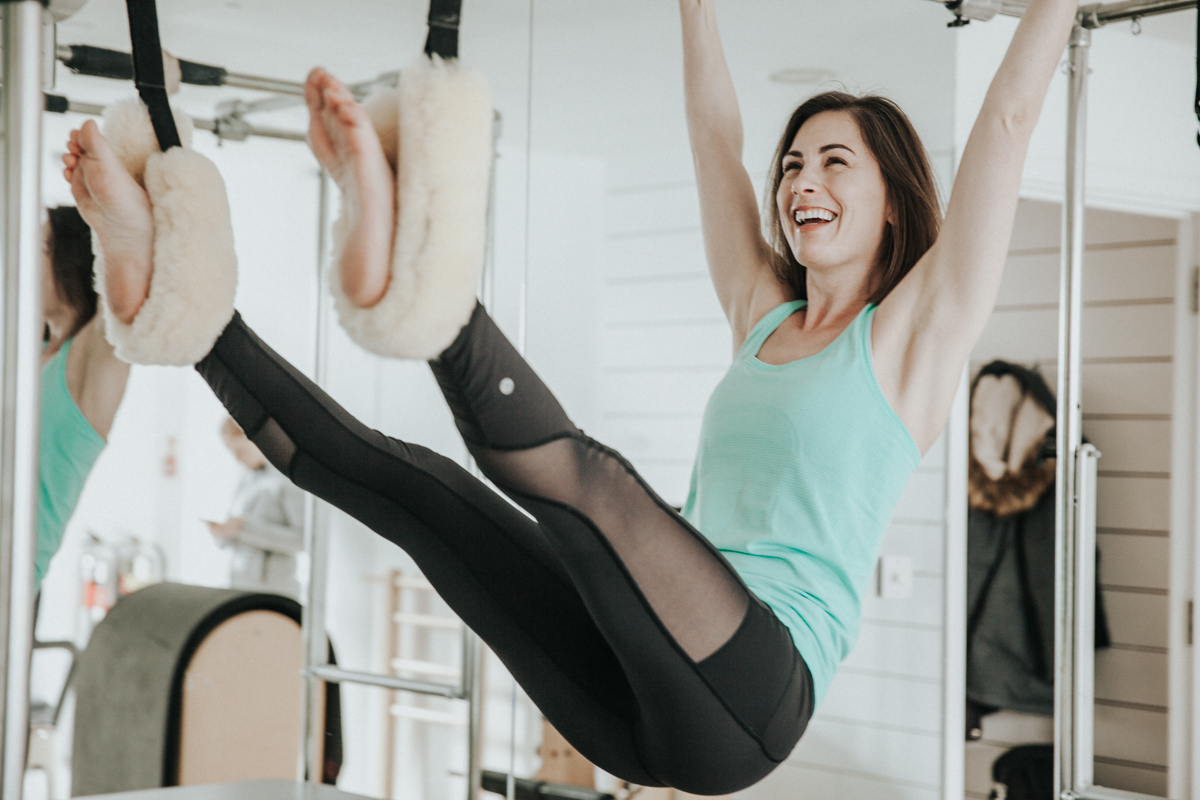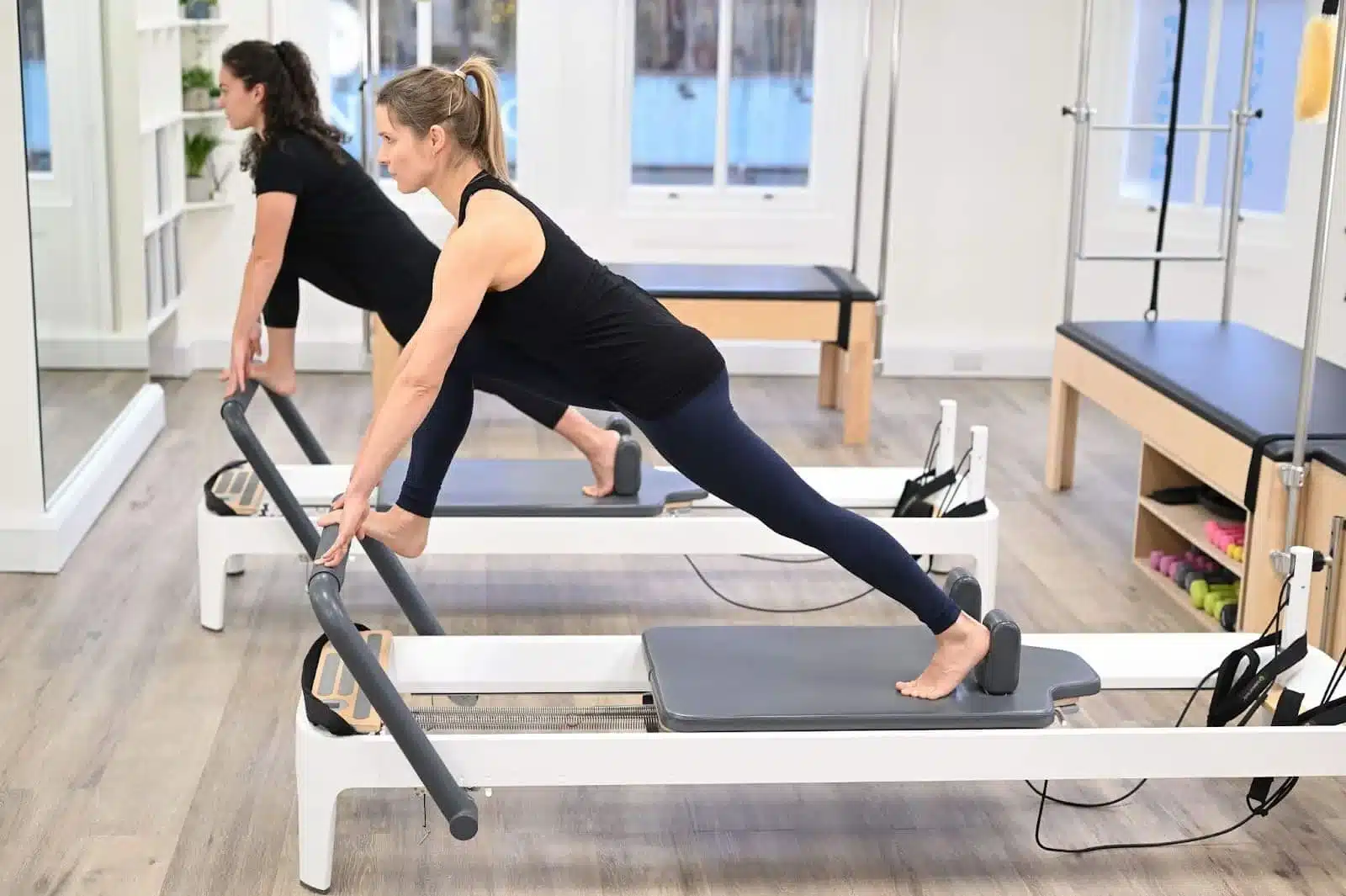Key Contributor: Susie Martin, Chartered Physiotherapist
Key Takeaways
- To use a Pilates reformer you will need to understand the different parts of the reformer and what they do – including the sliding carriage, the straps and pulleys, the spring resistance and the footbar.
- Learn the basic set up of the reformer – where the footbar is positioned, which loops to use on the straps and how to change the spring resistance.
- Learn some of the basic reformer Pilates exercises and how to do them safely, as well as how to set up the springs for each. This is best done under the guidance of a well qualified Pilates instructor.
Real life step by step guide for using a Pilates Reformer
What Are the Key Steps to Using a Pilates Reformer?
Step 1: Familiarise Yourself with the Equipment
There are many different brands of Pilates reformer but most reformers should have the following.
A frame – metal or wood, this is the main support structure of the equipment
A carriage – this is the sliding platform that characterises a reformer. You can lie, sit, kneel or stand on the carriage to perform and endless range of different exercises.
Springs – there are 4 to 5 springs attaching the reformer carriage to the frame. These provide resistance for the exercises, but can also be assistive in the movements. Most modern reformers have springs of varying resistance, whereas classical Pilates reformers have springs that are all the same resistance.
Straps – the reformer has looped straps that are attached by cables to the carriage. These can be used for your legs or arms. As you pull on the cables, this moves the carriage, usually with you on it!
Footbar – all reformers will have a footbar, usually of varying height, this can be adjusted to suit the exercise, but can also be adjusted to suit varying heights.
Footplate – the reformer usually has a small fixed platform at the foot end of the carriage that provides an additional surface to stand on, or place your hands or feet on during exercises.
Long box – the long box is an additional accessory for the reformer that means you can alter the height of yourself relative to the carriage, footbar and straps – this gives you even more variety in the exercises that you can do.
Jump board – the jumpboard is another popular reformer accessory – you can insert the jumpboard in by the foot bar, and perform jumping and hopping exercises on the reformer.
Step 2: Learn the best way to get on and off the Reformer
To lie on the reformer we recommend sitting at the very end of the carriage and lying down on to your side and then rolling on to your back.
To get your feet in and out of the straps, have both feet on the footbar, press the carriage out, then place one foot into the straps, gently press into the strap, to get more tension on the cable, and then slowly lift your other leg up and place it into the other strap. Keep your knees bent up towards your body to start with, and then press the legs out and up.
Step 3: Adjust your springs
The springs will need to be adjusted differently according to your body weight, height and the particular exercise you will be doing. Each spring is attached by a loop that goes over a hook. Gently pull the spring to lengthen it, in order to add or remove the spring from the hook. Avoid yanking the spring.
For some exercises adding more springs will add more resistance, to make the exercise harder. For others, adding more springs will make the exercise easier, and having fewer springs will make the exercise harder. This can be a little bit confusing, so it’s helpful to have a really good understanding of the exercises and what they do, to know how to adjust the springs.
Step 4: Practice basic moves
Understanding the fundamentals of reformer Pilates will help you when you progress to more challenging exercises. The fundamental principles of Pilates include concentration, control, precision and flow. Practicing simple movements allows you to concentrate on your body and the sensations of your position and movement. In this way you cultivate a greater sense of body awareness and more effective and easeful movements.
Another common principle in Pilates is that of movement dissociation – that is – the ability to isolate one moving body part from the adjacent ones. This principle is at work during the beginner exercises “Footwork”, “Feet in Straps” and “Supine Arm Series”. Once you can really appreciate this principle in your own body, you will be improving your body awareness and can transfer the principle to more advanced exercises.
Step 5: Practice movement control
In some settings, the reformer is used a bit like a piece of gym equipment – the resistance is increased and people are pumping away at the movements, as hard and as fast as they can. However, if we are working on the Pilates principle of control – slow movements should be mastered as well. Slow movement is controlled movement.
A helpful tip here is to see if you can move the reformer carriage as quietly as possible. The faster you move, the more sound it makes, the slower you move, the more noise it makes. If we are moving in a fast, uncontrolled way, we will often know about it because the reformer carriage will bang!
So aim to be as quiet in the movements as possible, and see if you can develop movement control.
Learning timeline for reformer Pilates
After 1 Session
- Be familiar with the basic parts of the reformer equipment.
- Understand basic machine setup.
- Understand how to get on and off the reformer safely.
- Complete a few beginner exercises with guidance.
After 1 Month
- Greater confidence with beginner exercises.
- Introduction to a greater repertoire of exercises.
- Improved flexibility.
- Start to notice more strength and control
After 3 Months
- More fluid transitions between exercises.
- Noticeably greater all over body strength.
- More challenging exercises – using more resistance or more body weight.
How to maximise your reformer Pilates learning curve?
In order to progress with the reformer, it is a good idea to practice regularly. Participating in reformer Pilates a minimum of once per week will ensure that you learn a bit more each time you go – instead of having to start from the beginning again.
Once you have mastered good movement control in the basic exercises, you can progress – to either exercises that are more physically challenging, or to exercises that are mentally challenging – involving more co-ordination or choreography.
One to one tuition will supercharge your progress, as through one to one sessions, you get to understand what each exercise is for, as well as work on exercises that are tailored to your particular needs and level.
Pay attention in reformer classes to the names of the exercises. This will make it easier to recognise the movements that are coming up. Instead of having to look around at everyone else to figure out what to do, you will understand the movements that are coming next.
FAQs
“Can beginners use a Pilates reformer?”
Yes, beginners can use a Pilates reformer. However, if you have never done Pilates before or used a Pilates reformer, we would recommend that you have some one-to-one sessions to pick up the basics of both Pilates and reformer use. Having individualised tuition will help you learn how to operate the reformer safely, as well as understand the technical basics of Pilates. It will also help you understand the right level of exercises for you, which means you are less likely to be working with ineffective exercises or exercises that result in pain or injury.
“Do I need to be flexible to start?”
No, you don’t need to be flexible to start reformer Pilates. Whilst some Pilates exercises require flexibility, there are lots of exercises to suit all levels of flexibility. Pilates can really help improve your flexibility and mobility, so you may find that with practice, you can achieve exercises that you had difficulty with in the beginning. Pilates isn’t only about flexibility, it is really helpful for improving your strength, and this is important for everyone, as it helps you to function better in your day to day life.
“What should I wear for reformer Pilates?”
It is important to wear comfortable clothing that allows for movement when you do reformer Pilates. More close fitting clothing is a good idea, so that you don’t get any extra bits of material stuck in the reformer equipment. Close fitting clothing also makes it easier for your instructor to see how you are moving.
Hair should be tied back and any jewellery kept to a minimum, so that it doesn’t get caught in moving parts of the machinery. Pilates is usually done barefoot, if you are in a public studio, socks are recommended. Pilates specific socks with grip are helpful for a lot of reformer exercises, as they can stop you sliding on the equipment.
If you prefer to wear shorts, be aware that shorter lengths can be revealing if you are lying down, so make sure that you have close fitting styles or a tighter layer underneath more baggy shorts.
For a more detailed discussion of what to wear – you can read our blog here.
Conclusion
The Pilates reformer machine may, at first glance, seem intimidating. However, the Pilates reformer is suitable for anyone, beginners and advanced alike. If you are just starting out, the best thing to do is familiarise yourself with the equipment and settings.
Next, get to grips with the basic Pilates reformer repertoire. We would recommend working 1:1 with a Pilates instructor to do this as this will help you to get the most out of your sessions. In addition 1:1 sessions can provide you with a customised exercise programme that is appropriate for your level and for your goals.
Once you’ve done this, you’re ready to go out and try other types of reformer Pilates, or maybe even explore the other Pilates equipment!
Feeling inspired?
If you want to experience the Complete difference and discover the benefits of one-to-one Pilates, book a session at one of our London studios or online today.
Our physiotherapist-led Pilates studios in Chelsea, our Angel Pilates studio and our Pilates studio in City, offer a highly tailored approach to your Pilates training, whether your goal is to manage a health condition, rehabilitate from an injury or to improve your strength and fitness.
Get in touch with us via email or contact us on 0203 764 5668 for further information.
Education is key:
These blogs are designed to give information to everyone, however, it is important to remember that everyone is different! If you have not seen one of our therapists and have any questions about injuries, what you have read or whether this may be useful to you, please just ask. We are more than happy to help anyone and point you in the right direction. Our biggest belief is that education is key. The more you understand about your injury, illness and movement, the more you are likely to improve.






